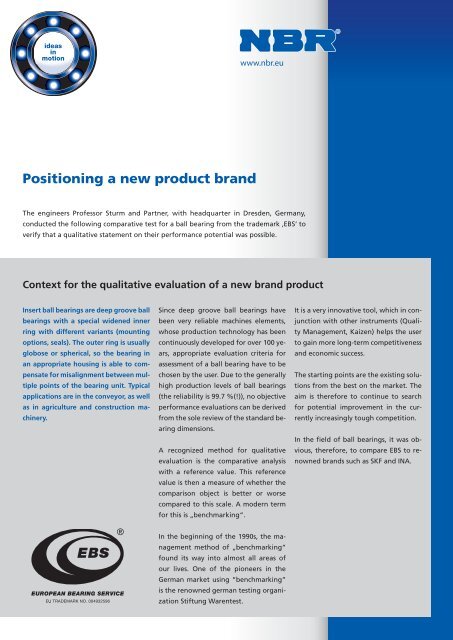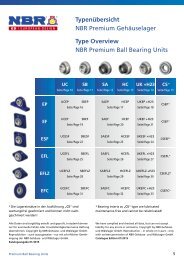NBR_EBS_benchmarking test
You also want an ePaper? Increase the reach of your titles
YUMPU automatically turns print PDFs into web optimized ePapers that Google loves.
www.nbr.eu<br />
Positioning a new product brand<br />
The engineers Professor Sturm and Partner, with headquarter in Dresden, Germany,<br />
conducted the following comparative <strong>test</strong> for a ball bearing from the trademark ‚<strong>EBS</strong>‘ to<br />
verify that a qualitative statement on their performance potential was possible.<br />
Context for the qualitative evaluation of a new brand product<br />
Insert ball bearings are deep groove ball<br />
bearings with a special widened inner<br />
ring with different variants (mounting<br />
options, seals). The outer ring is usually<br />
globose or spherical, so the bearing in<br />
an appropriate housing is able to compensate<br />
for misalignment between multiple<br />
points of the bearing unit. Typical<br />
applications are in the conveyor, as well<br />
as in agriculture and construction machinery.<br />
Since deep groove ball bearings have<br />
been very reliable machines elements,<br />
whose production technology has been<br />
continuously developed for over 100 years,<br />
appropriate evaluation criteria for<br />
assessment of a ball bearing have to be<br />
chosen by the user. Due to the generally<br />
high production levels of ball bearings<br />
(the reliability is 99.7 %(!)), no objective<br />
performance evaluations can be derived<br />
from the sole review of the standard bearing<br />
dimensions.<br />
A recognized method for qualitative<br />
evaluation is the comparative analysis<br />
with a reference value. This reference<br />
value is then a measure of whether the<br />
comparison object is better or worse<br />
compared to this scale. A modern term<br />
for this is „<strong>benchmarking</strong>“.<br />
It is a very innovative tool, which in conjunction<br />
with other instruments (Quality<br />
Management, Kaizen) helps the user<br />
to gain more long-term competitiveness<br />
and economic success.<br />
The starting points are the existing solutions<br />
from the best on the market. The<br />
aim is therefore to continue to search<br />
for potential improvement in the currently<br />
increasingly tough competition.<br />
In the field of ball bearings, it was obvious,<br />
therefore, to compare <strong>EBS</strong> to renowned<br />
brands such as SKF and INA.<br />
In the beginning of the 1990s, the management<br />
method of „<strong>benchmarking</strong>“<br />
found its way into almost all areas of<br />
our lives. One of the pioneers in the<br />
German market using “<strong>benchmarking</strong>”<br />
is the renowned german <strong>test</strong>ing organization<br />
Stiftung Waren<strong>test</strong>.
www.nbr.eu<br />
A machine is only as good as its ball bearings –<br />
conducting a series of <strong>test</strong>s<br />
To be eligible for practically relevant results,<br />
serially produced comparable insert<br />
ball bearing types and dimensions<br />
were randomly selected and bought on<br />
the technical trading market.<br />
Insert ball bearings are internationally<br />
standardized. Therefore, we deemed it<br />
necessary to check the main geometric<br />
dimensions (bore, outside diameter,<br />
width) according to DIN 620. Since the<br />
complete bearings are factory greased,<br />
the clearence could not be verified.<br />
A ball bearing is always an interconnected<br />
system of individual components<br />
(rings, balls, cages, seals, lubricants).<br />
When these components are optimally<br />
tuned, low running noise is the desired<br />
result. That is, a ball bearing of<br />
good quality is usually very quiet. Any<br />
unevenness in the surface (scratches,<br />
dirt, lack of lubricant film, format errors,<br />
unbalances) causes a vibration, and<br />
thus increased noise.<br />
During the examination, it turned out<br />
that the bearings of SKF brand became<br />
remarkably warm compared to the<br />
other brands of bearings. The intrinsic<br />
temperature development in a bearing<br />
is usually of significance to the quality<br />
of bearing. So if the intrinsic temperature<br />
on a self-noise <strong>test</strong> bench (low<br />
load, good heat dissipation) increases<br />
greatly within a short time, there will<br />
remain correspondingly less reserve<br />
stock (external heating) in the installed<br />
condition.<br />
Therefore, the temporal evolution of<br />
the self-heating was also compared.<br />
In the standard DIN 5426-1, the noise<br />
<strong>test</strong>ing results on fully assembled (not<br />
yet installed) ball bearings are written<br />
down. This is done to measure the impact<br />
sound under a defined load and<br />
speed. The vibration velocity is measured<br />
by a sensor in three frequency<br />
bands. From manufacturer to manufacturer,<br />
the measuring tools are scarcely<br />
directly comparable. Therefore, a comparative<br />
measurement is warranted. In<br />
addition, modern <strong>test</strong> equipment measures<br />
the vibration acceleration which<br />
allows additional frequency analysis<br />
and evaluation.
Evaluation of <strong>test</strong> results and conclusions<br />
The comparison is a snapshot of a single,<br />
randomly selected bearing size (SB 204).<br />
Based on these results, further comparisons<br />
are recommended. However, it becomes<br />
quite evident that the new brand<br />
<strong>EBS</strong> has an enormous potential.<br />
The original aim of these <strong>test</strong>s was to<br />
show the technical status of the brand<br />
<strong>EBS</strong>, compared to qualitatively wellknown<br />
and prestigious brands such as<br />
SKF and INA. The <strong>test</strong>s brought up surprising<br />
findings involving ready to install,<br />
commercial bearings.<br />
While the INA product showed significantly<br />
higher noise levels, the SKF bearings<br />
showed a sharp rise in net temperature.<br />
In both comparisons, the bearings of<br />
<strong>EBS</strong> compared to SKF and INA performed<br />
better and showed the great achievement<br />
potential of the brand against<br />
renowned competitors.<br />
Within this snapshot, only <strong>EBS</strong> shows<br />
low self-heating and low running noise.<br />
This implicates a superior aligned system<br />
of the individual ball bearing components<br />
with reduced friction, higher<br />
power efficiency and thus increased system<br />
effectiveness.<br />
This comparison gives the user an enormous<br />
potential for sustainable economic<br />
and ecological advantages in competition.<br />
The comparison <strong>test</strong> <strong>EBS</strong> – INA – SKF<br />
1.1 Basic data<br />
Period<br />
The <strong>test</strong>s were made in April 2009.<br />
Examiner<br />
Dipl.-Ing. Jan Sparmann and Dr.-Ing.<br />
Gerd Ellmer, engineers Prof Sturm and<br />
Partner GmbH, Dresden, Germany<br />
Veryfied Bearings<br />
The following bearings were selected<br />
for consideration:<br />
1. GAY 20 NPPB, INA, Slovakia<br />
(<strong>test</strong> item-no. 1, 2, 3, 11, 12, 13)<br />
2. YAT 204 SKF, Italy<br />
(<strong>test</strong> item-no. 4, 5, 6, 14, 15, 16) –<br />
single-packed<br />
3. SB 204, <strong>EBS</strong>, China<br />
(<strong>test</strong> item-no. 7, 8, 9) – single-packed<br />
Noise <strong>test</strong><br />
Ball bearing noise <strong>test</strong> stand WGP-1<br />
(DIN 5426-1), built in 2008<br />
Test load: 50 N (axial)<br />
Contact force of sensor: 5 N<br />
Speed: 1800 RPM or 3000 RPM<br />
Measurements<br />
• Absolute RMS values v (4 bands)<br />
in microns / s,<br />
• Relative RMS values v (4 bands)<br />
in %<br />
• dB values (4 bands)<br />
reference value of 1 micron / s<br />
• Absolute RMS values a (4 bands)<br />
in mm / s ²,<br />
• Relative RMS values a (4 bands)<br />
in %<br />
• dB values (4 bands)<br />
reference value of 1 mm / s ²<br />
Evaluations<br />
Rolling Bearing Analysis, Intrinsic Curve<br />
Spectrum<br />
Accuracy<br />
Amplitude measurement resolution of<br />
0.15 mm / s ²<br />
Piezoelectric Sensor<br />
Date of last calibration<br />
08/14/2008 with vibrating table VC 10<br />
Temperature Meter<br />
VOLTCRAFT IR-364<br />
(Infrared Thermometer) –50 to 900 °C<br />
Accuracy: + /– 1.5 % of reading + /– 2 °C<br />
(–20 to +200 °C)
www.nbr.eu<br />
1.2 Measurement<br />
Bearing-noise <strong>test</strong><br />
Attachment 1: Report <strong>EBS</strong> INA SKF<br />
bearing noise-<strong>test</strong> SB 204<br />
Description: The bearings were <strong>test</strong>ed<br />
with disassembled mounting screw from<br />
both sides (a, b) with two speeds (1800,<br />
3000 RPM).<br />
These were the values of the compared<br />
oscillation acceleration aeff (mm/ s ²) in<br />
the frequency range 50 – 4500 Hz.<br />
To ensure the balls rolling secure, the<br />
bearings were employed axial from one<br />
side with a load of 50 N (DIN 5426-1).<br />
Bearing self-warming <strong>test</strong><br />
Attachement 2: Report <strong>EBS</strong> INA SKF<br />
self-warming <strong>test</strong> SB 204<br />
Description: On the basis of observed<br />
strong heating of the SKF bearings,<br />
further bearings were re-ordered and<br />
only immediatelyprior to the <strong>test</strong>, the<br />
individual packaging was removed.<br />
The bearings were visually inspected and<br />
the screws removed. It was noted that<br />
the threads were improperly worked<br />
out. Sometimes there was a sharp ridge.<br />
Some of the threaded holes contained<br />
significant bore chips.<br />
The <strong>test</strong> was conducted at a implemented<br />
speed of 3000 RPM. Every 5 minutes,<br />
a temperature measurement was made,<br />
using a contactless infrared thermometer.<br />
The temperature over the entire visible<br />
surface of the bearing was scanned and<br />
the maximum value noted.<br />
Earlier <strong>test</strong>s (the sound <strong>test</strong>s) had shown<br />
a stabilization of the operating temperature<br />
of the INA- and <strong>EBS</strong>-bearings<br />
within 20 minutes. Hence, there was a<br />
termination of the measurement after<br />
this time, regardless of whether the<br />
temperature of the SKF-bearing may<br />
have shown further increase.<br />
The measurements were made, different to the noise <strong>test</strong>, only from one side.<br />
1.3 Diagrams<br />
Bearing-noise <strong>test</strong><br />
Attachement 3: Diagram <strong>EBS</strong> INA SKF bearing noise-<strong>test</strong> SB 204<br />
Bearing self-warming <strong>test</strong><br />
Attachment 4: Diagram <strong>EBS</strong> INA SKF self-warming <strong>test</strong> SB 204<br />
<strong>NBR</strong> Gehäuse- & Wälzlager GmbH<br />
Geister Landweg 15<br />
D-48153 Münster, Germany<br />
Fon + 49 (0) 2 51 / 987 22 222<br />
Fax + 49 (0) 2 51 / 987 22 215<br />
info@nbr.eu<br />
Please contact us, we advise you gladly.<br />
www.nbr.eu
Anlage 3: Diagramm <strong>EBS</strong> INA SKF Geräuschprüfung SB 204<br />
10.000<br />
Ergebnisse der Lagergeräuschuntersuchung der Marke <strong>EBS</strong><br />
Typ: SB 204<br />
Drehzahlen n = 1.800 bzw 3.000 U / min<br />
Geräuschpegel<br />
Effektivwerte der Schwingbeschleunigung a eff in mm/s²<br />
9.000<br />
8.000<br />
7.000<br />
6.000<br />
5.000<br />
4.000<br />
3.000<br />
2.000<br />
1.000<br />
0<br />
INA SKF <strong>EBS</strong>
Anlage 1: Protokoll <strong>EBS</strong> INA SKF Geräusch<strong>test</strong> SB 204
Anlage 2: Protokoll <strong>EBS</strong> INA SKF Eigenerwärmung SB 204
Anlage 4: Diagramm <strong>EBS</strong> INA SKF Eigenerwärmung SB 204<br />
100,0<br />
Lager-Eigenerwärmungs-Test<br />
Typ: SB 204<br />
Drehzahl: 3.000 U/min; Dauer: 20 min<br />
90,0<br />
80,0<br />
Lagertemperatur / °C<br />
70,0<br />
60,0<br />
50,0<br />
40,0<br />
30,0<br />
<strong>EBS</strong> 1<br />
<strong>EBS</strong> 2<br />
<strong>EBS</strong> 3<br />
INA 1<br />
INA 2<br />
INA 3<br />
SKF 1<br />
SKF 2<br />
SKF 3<br />
20,0<br />
10,0<br />
0,0<br />
0 5 10 15 20<br />
Zeit / min



